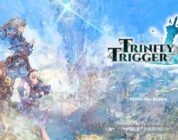For most of my gaming life, Xbox consoles have been pretty much absent. PC, Nintendo, and PlayStation have always fulfilled my gaming desires. There are plenty of reasons for this, and I’m not going to bother readers in this review. Every now and then, though, a game would come out that would make me wish I had an Xbox console; The Last Remnant was one of those games. As a big fan of JRPGs, to have a brand new Square Enix game come out that I couldn’t play made me wish my wallet held more money for an Xbox 360. By the time Last Remnant came to PC, there were already so many other games coming out that I also wanted to play that I never got around to getting it. Finally, eleven years later, I get my chance as the game has been remastered and released on the Switch. How does Last Remnant stand the test of time, let’s find out!
Last Remnant follows the story of Rush in the quest to rescue his sister, who has gone missing, and in the process realizes that there is a much more nefarious plot that he must foil in order to save her. The game features a large world with numerous notable locations across multiple kingdoms with wilderness, cities, ruins, caverns, and everything in between. The overall story has a serious tone with intense action, emotions, while balancing the character driven moments and story with political intrigue and the JRPG classic worldwide threat plot.
The gameplay is primarily a typical turn based JRPG but mixes up the equation with players giving commands to squads rather than individual characters. As I progressed through Last Remnant, I ranked up and was granted command over more units and more squads, eventually being able to have twenty five units across five squads and even more on deck to swap in and out as needed. Commands are offered based on members in the squad, distance from the target, whether or not the player is already engaged, and whether or not the enemy is already engaged. There are also commands that prioritize healing and offering support arts.
At the beginning of each round, commands are given to each squad. Once that has been decided, the action unfolds, during which players may be prompted with a quick button press that if successfully hit can trigger combos or critical hits. One of the main issues of this system is that it’s difficult to determine what order the commands issued will end up being in. Frustration would bubble up when I commanded one unit to heal another and then the one that needed healing would end up going first and being defeated, which would change what the healer group was supposed to do. The order of these commands is determined by a speed stat, but during combat this order is not readily available, nor are the stats.
This points to the biggest setback Last Remnant has, an overall lack of available in-game information.
The Last Remnant came out in a day and age where printed game manuals and game guide walkthroughs were still prevalent. As a result, a lot of information isn’t available in-game and could take hundreds upon hundreds of hours to uncover independent of such assistance. There is no digital manual included with the game and the game doesn’t teach many of the important aspects to the crafting and combat.
I spent hours looking over forums and wiki entries related to The Last Remnant to learn about even some of the most basic functions of game progression and the crafting system. That’s how I discovered how the battle rank relates to recruits, how individual stats increase over time, and where to find specific crafting materials. While I could see these things happening and what materials I may need, I didn’t know how they happened or where to find them. As a new player, it became more difficult than I felt was necessary.
I’ll also admit that this could be a symptom of expectations of modern conveniences that are built into today’s games. As a remaster, it would have been nice to see some of these conveniences built into this version, or at the very least an accessible digital game manual. Something like that would be fairly easy to provide, and is necessary for dense games like this that came with a manual in its original release.
On the positive side of the game’s mechanics, I enjoyed tinkering with the job system, which is determined over time by characters’ actions, combat arts used, and weapons equipped. Note that Rush is the only character players have control over in terms of equipment. There’s definitely some replay value in trying different builds and roles for Rush for those that like to experiment with various builds.
Visually, The Last Remnant Remastered overall looks pretty good. Even though it isn’t a fully rebuilt version of the game, rendering at a higher quality brings out clean lines and better looking textures than looking at the screenshots of the original version. The game does suffer from Square Enix’s “Brown Phase” where their games were covered in earthy browns, greens, and blacks with fairly flat lighting.
I also like the character designs, particularly the non-human characters. They did a great job in distinguishing them apart from one another in both look and personality and at a glance I was able to tell them apart from other members of the same race. I also really enjoyed the blending of cultural clothing styles to create something distinct. There seems to be thought given to the non-human characters’ clothing in how their clothing would fit and how it is built from their cultures. In many ways the design, direction, and overall look reminds me of Final Fantasy XII, of which I have previously reviewed.
That’s where my enjoyment of the visuals ends though. Many of the environments tend to be on the empty and bland side, which is a side effect of the time when they had the capability of creating larger environments but not quite the ability or knowledge of how to fill them with things to make them feel fully fleshed out. There were also regular instances of huge drops in framerate, and some of the animations come across as pretty stiff when not a part of a cutscene. These framerate issues would hinder my ability to perform the combat’s quick time prompts. Furthermore, sometimes the prompt would appear behind another graphic asset that was declaring the start of the round.
On the audio front, The Last Remnant is fairly mixed. The voice acting has a wide range of quality, but the main cast is done well enough and I found that I was usually engaged with the content of the story contained in the cutscenes. For music, there are a couple of notable tracks that I enjoyed with their rock influences. Aside from that, I didn’t really notice any music and I won’t be listening to this soundtrack outside of the game itself.
My eleven year wait has ended in what I’d call satisfied disappointment. I experienced an engaging story and fantastic world with rich characters and a combat system that could have really been amazing with some tweaking. Having this experience on a portable device was nice, however, the frame rate issues and the study time investment made this a difficult game to enjoy to its full potential.
If you’ve always wondered what this game was like, have some strong nostalgia for it, or are interested in a game that experiments with the JRPG formula, The Last Remnant Remastered is an overall good experience, provided you have the patience to leave the game to read up on things that would normally be included in-game in a more modern gaming experience, or in a in-game guide or manual in the past.
More information about The Last Remnant Remastered can be found on the official website. A digital copy of the game was provided for the purposes of this review.








